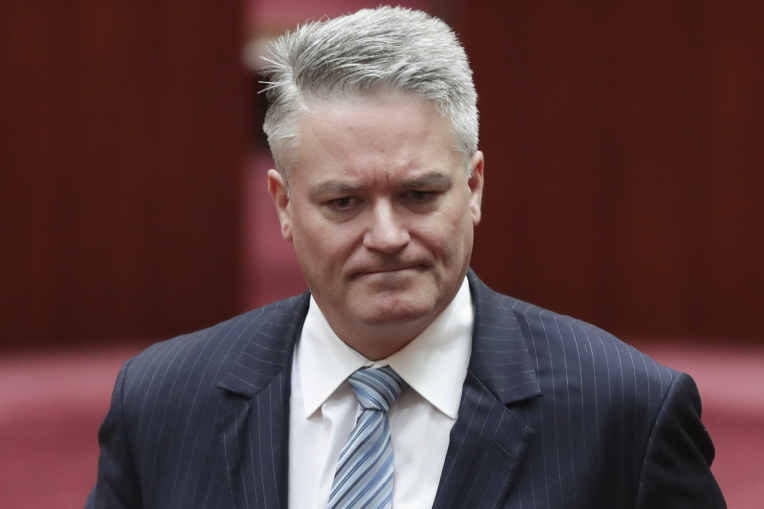Budget deficit hits $40b and still rising
by John KehoeThe federal budget deficit had blown out to $40 billion by the end of April, as coronavirus emergency spending began to kick in and tax revenue was squeezed.
Department of Finance figures showed an underlying cash deficit of $39.99 billion in the 10 months to April 30, versus a forecast in December of a deficit of $7.6 billion.

Total government payments to the end of April were $12 billion higher than assumed and tax revenue was almost $20 billion lower than forecast.
The government has pledged about $150 billion in fiscal support over the next two years, including JobKeeper wage subsidies, doubling the JobSeeker unemployment benefit, cashflow tax refunds for small business, industry assistance and health spending.
Prime Minister Scott Morrison said on Friday the government would continue to do the "heavy fiscal lifting".
A range of measures, not just JobKeeper, could be extended or tailored for certain sectors when the payments expired around late September, he said.
"What is important to know is that as time goes on, more of the economy gets stronger," he said.
"And more of your economy is less in need of those specific supports than it was at first. But some sectors of your economy will need them for longer.
"Now, whether that's in the [JobKeeper] measures you're talking about or in other measures, well, that's an option for the government to consider."
$100 billion deficit predicted
Market economists are tipping the deficit to hit around $100 billion in 2020-21 and 2021-22.
Finance Minister Mathias Cormann said the COVID-19 pandemic was having a negative impact on the budget.
"As a government we committed to the fight against the virus and to building the economic bridge to the other side."
The government will provide an economic and fiscal update in June following the release of the March quarter economic growth figures.
A full budget is scheduled for October.
Meanwhile, lending growth froze in April for the first time since 2011 because of a plunge in credit card spending by shoppers during the coronavirus-induced business shutdowns.
Personal lending, excluding housing, recorded its deepest contraction since the Reserve Bank of Australia records, dating back to 1976.
Personal credit growth fell 3 per cent in April and declined 9.3 per cent through the 12 months.
The plunge coincided with widespread shutdowns of retailers and other shops, as well as commercial banks offering fee waivers and credit card repayment deferrals.
There was no credit growth, including for businesses and housing, for April, recording 0.0 per cent. It was a weak 3.6 per cent in year-end terms.
Housing credit growth slowed to 0.2 per cent in April and was 3.1 per cent at year end.
Business lending continued to slow for the month, eking out 0.1 per cent growth in April. Business credit expanded at 6.7 per cent over the year.
Goldman Sachs chief economist Andrew Boak said credit growth had "stopped".
"Total private sector credit was flat in April, against expectations of a moderate increase," he said.
"The deceleration was fairly broad based across components, with personal credit contracting very sharply."
However, since then there has been signs card spending has rebounded.
Credit and debit card data from Commonwealth Bank of Australia and ANZ show consumer spending has recovered so much that it is now above where it was this time last year.
For the week to May 22, personal spending was in positive territory, up 2.3 per cent on the same week last year, according to ANZ's data, while CBA's shows it was up 4 per cent.
Updated analysis from payments into CBA bank accounts indicates that the reduction in household income from job losses continues to be more than offset by an increase in government benefit payments.
CBA economist Gareth Aird said the increase in government payments such as JobKeeper and JobSeeker had boosted people's overall pay above pre‑COVID‑19 levels.
"Growth in government benefits paid plus wages and salaries paid sits
comfortably above pre‑COVID‑19 levels," he said.
"The state of the economy when the fiscal stimulus fades in late‑September/October, as well as any changes in policy related to JobKeeper and JobSeeker, will be critical to the outlook for household income."
Overall, the RBA April credit growth is the weakest monthly result since total credit shrank 0.1 per cent in June 2011, when fears were stoked during the European sovereign debt crisis and the local stock market was falling.
The federal government, RBA and commercial banks have instigated several emergency measures to make sure cheap credit keeps flowing to households and business during the coronavirus economic downturn.
These include offering $40 billion in government guaranteed loans for small business, a $100 billion RBA funding facility for commercial banks and the RBA buying more than $50 billion of government bonds to keep borrowing costs low across the economy.